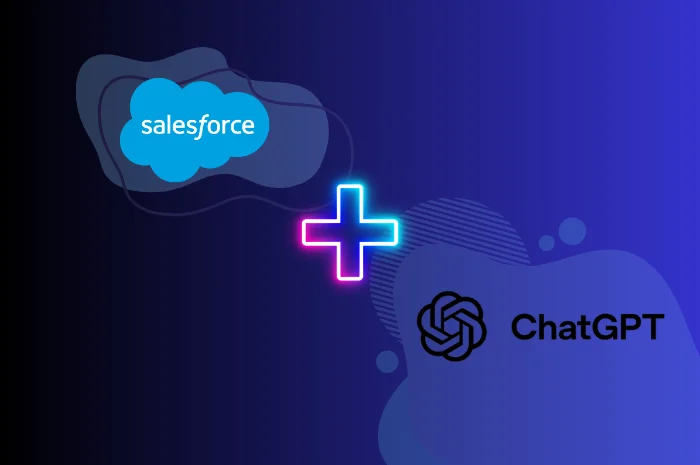In today’s fast-paced digital world, businesses constantly look for ways to enhance productivity, improve customer engagement, and make their processes more intelligent. Artificial Intelligence (AI) plays a vital role in this transformation- and one of the most practical implementations is integrating AI models like ChatGPT with powerful enterprise systems such as Salesforce.
By integrating ChatGPT into Salesforce, organizations can revolutionize how their teams interact with data, customers, and internal systems. From automating responses and generating insights to assisting teams with natural language understanding, this integration bridges the gap between human-like conversations and structured CRM data.
Why Integrate ChatGPT with Salesforce?
Salesforce is a leading CRM platform that manages customer data, automates workflows, and streamlines business operations. However, when paired with ChatGPT’s advanced conversational and analytical abilities, it becomes even more powerful. Here is why integration makes sense:
- Smarter Interactions: Enable AI-powered chat support or automated assistants that respond intelligently to customer queries.
- Productivity Boost: Automate repetitive tasks like drafting emails, creating case summaries, or data entry.
- Data-Driven Decisions: Use AI to interpret large sets of CRM data and provide actionable insights in natural language.
- Personalized Engagement: Tailor communication and recommendations for customers based on their preferences and past behavior.
- Time Efficiency: Reduce manual workload and let AI handle first-level support or data analysis.
In essence, integrating ChatGPT with Salesforce allows businesses to deliver faster, more human-like, and efficient customer experiences.
Real-World Use Cases

Here are some ways this integration can transform business workflows across departments:
- Customer Support Automation: ChatGPT can act as a virtual agent that handles basic support queries, generates case summaries, and drafts empathetic responses for agents to review.
- Sales Assistance: It can help sales representatives compose personalized follow-up emails, identify opportunities, and even generate quick insights on leads.
- Marketing Support: Use ChatGPT to generate engaging content, campaign ideas, or audience insights based on CRM data.
- Internal Knowledge Assistant: Allow employees to ask questions like, “Show me open deals in the pipeline” or “Summarize the last five customer interactions” and get instant, AI-generated answers.
- Data Cleansing and Enrichment: Automatically detect missing or inconsistent data and suggest corrections or enrichments.
These examples only scratch the surface of what’s possible when AI and CRM intelligence work together.
ChatGPT Integration Challenges
Before diving into implementation, it is important to understand the challenges that come with this integration:
- Data Privacy: Ensure no sensitive or confidential customer data is shared without proper masking or encryption.
- Accuracy: While ChatGPT is advanced, it can sometimes produce inaccurate or incomplete responses- human validation is important.
- Latency and Cost: Every API call adds response time and cost. It’s vital to balance performance with efficiency.
- Governance: Establish clear usage policies, logging, and monitoring systems to maintain compliance and transparency.
- User Training: Educate users about when and how to trust AI-generated suggestions.
By addressing these early, you can design a more secure and effective integration.
How to Integrate ChatGPT with Salesforce

Let’s explore how to connect ChatGPT with Salesforce in a structured, secure, and scalable manner.
Step 1: Set Up the Essentials
Before integrating, ensure the following prerequisites are met:
- A Salesforce developer or sandbox environment.
- Access to the OpenAI API and an active API key.
- Admin access in Salesforce to configure permissions and settings.
- Defined use cases and prompts for interaction.
This preparation ensures that ChatGPT integration is smooth and aligned with your business goals.
Step 2: Configure Salesforce for API Callouts
Salesforce restricts external API requests by default. To connect with ChatGPT’s API, configure the following:
- Named Credentials or Remote Site Settings: Add OpenAI’s endpoint as a trusted site. Using Named Credentials is more secure as it manages authentication centrally.
- Custom Metadata: Store parameters such as model type, token limit, or temperature so they can be updated without modifying code.
- Permissions: Ensure that your integration user has API callout permissions enabled.
Once these configurations are in place, Salesforce is ready to communicate with the ChatGPT API.
Step 3: Create an Apex Wrapper for ChatGPT
Apex classes act as the bridge between Salesforce and the OpenAI API. Here is a simplified example of how the integration works:
- The Apex class sends user prompts to ChatGPT’s API endpoint.
- The API processes the input and returns a structured response.
- The response is then displayed within Salesforce- either in a chat window, a record field, or as a suggestion.
This layer can be customized to handle specific use cases like summarization, question answering, or text generation.
Step 4: Build the User Interface
To make AI assistance accessible to Salesforce users, you can build an interface using Lightning Web Components (LWC) or Visualforce Pages.
For example, you might create a “Chat with AI” section where users type their questions and instantly get a relevant response from ChatGPT. The interface can be embedded into case records, opportunity pages, or dashboards- wherever real-time AI help is most useful.
Step 5: Automate with Flows and Triggers
Beyond direct chat interactions, ChatGPT can be integrated into Salesforce Flows or triggers to automate backend processes. For instance:
- After a case is closed, automatically generate a case summary using ChatGPT.
- When a new lead is added, have the AI draft a personalized introductory email.
- Run periodic data-cleanup jobs with AI recommendations.
Using asynchronous Apex or queueable jobs ensures these processes run efficiently without impacting real-time performance.
How to Test Integration

Testing is crucial to ensure that the integration performs reliably. Here is what to validate:
- Accuracy of responses– Are AI outputs relevant and error-free?
- Speed of response– Is the latency acceptable for your users?
- Error handling– Does the system gracefully handle API failures or rate limits?
- User experience– Are prompts intuitive and responses easy to understand?
Include user feedback loops during pilot testing. Gather insights to refine prompts, response formats, and overall design.
Monitoring, Maintenance, and Optimization
Once live, ongoing optimization is essential:
- Monitor API usage and costs regularly to stay within limits.
- Track error rates and response times to ensure smooth operation.
- Review prompt performance periodically and refine instructions for better output.
- Update security settings as needed to maintain compliance with data regulations.
Setting up dashboards and alerts can help your IT team maintain high system health and quick response to issues.
Governance and Security Best Practices
Since CRM data is often sensitive, strict governance and security policies are non-negotiable. Here is what to follow:
- Use least privilege access for integration users.
- Avoid sending personally identifiable or financial data to external APIs.
- Encrypt all API keys and stored responses.
- Keep audit logs of all AI interactions for accountability.
- Clearly label AI-generated content to maintain transparency.
- Regularly review usage and compliance policies.
Strong governance ensures the integration is not only functional but also responsible.
Future Possibilities
As AI continues to evolve, the possibilities for ChatGPT- Salesforce integration will only expand. Future enhancements may include:
- Fine-tuned AI models trained specifically on your CRM data.
- Deeper integration with Salesforce’s native Einstein AI features.
- Voice-enabled assistants for real-time support.
- AI-driven forecasting and opportunity scoring.
- Multi-language conversational support for global teams.
These innovations will further enhance how businesses use AI within Salesforce to drive intelligent automation and customer satisfaction.
Conclusion
Integrating ChatGPT with Salesforce is more than just adding AI- it is about reimagining how businesses interact with data, customers, and internal systems.
With the right implementation, companies can empower their teams to work smarter, respond faster, and deliver exceptional customer experiences. From automating everyday tasks to creating intelligent insights, the combination of ChatGPT and Salesforce brings the best of AI and CRM together.
Whether you are aiming to boost productivity, personalize customer interactions, or improve internal efficiency, this ChatGPT integration is a step toward the future of intelligent business operations.



